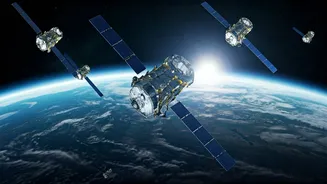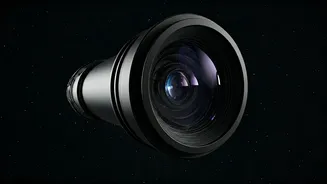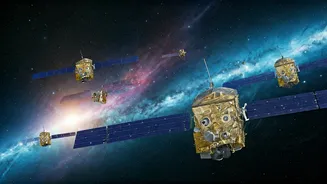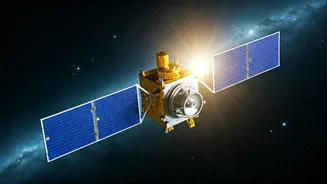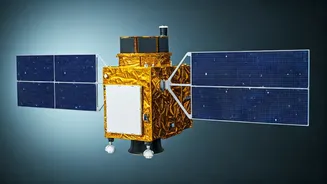SmallSat Education Surge
The SmallSat Education Conference is a platform for aerospace education, specifically designed for educators, parents, and students across middle school,
high school, and college levels. This event creates opportunities to explore the practical applications and theoretical underpinnings of small satellite technology. It enables the promotion of STEM education while inspiring the next generation of space enthusiasts and professionals. It provides a valuable forum to discuss the challenges and solutions relevant to small satellite development and deployment. The conference acts as a catalyst for innovation and collaboration, driving the integration of SmallSats into educational curricula and research programs. It provides networking opportunities, exposing participants to emerging trends, technologies, and opportunities in the aerospace industry.
Competitive Aerospace Landscape
The aerospace industry is marked by intense competition, with various companies and organizations vying for market share and technological dominance. This competitive landscape fosters innovation and rapid advancement in satellite technologies, driving the need to develop more efficient, reliable, and cost-effective solutions. Key players invest significantly in research and development to gain a competitive advantage, especially in crucial areas like satellite propulsion, communication systems, and data processing. Companies are also constantly seeking strategic partnerships and collaborations to broaden their capabilities and market reach. The competitive pressures are especially evident in the development of maneuverable satellites and the pursuit of contracts within the U.S. military satellite market, where success hinges on technological prowess, strategic positioning, and understanding of governmental requirements.
FAST Thruster Breakthrough
ECAPS's Fast-Start Thruster (FAST) technology is a significant innovation within the SmallSat sector. This technology offers rapid satellite deployment and maneuverability, improving overall mission efficiency. The FAST thruster facilitates quick satellite responses to mission changes, making it well-suited for a variety of tasks, from earth observation to communications. It can provide satellites with enhanced capabilities in terms of orbital adjustments, station-keeping, and avoiding space debris. This technology offers faster acceleration and improved operational flexibility for satellite operators. The advent of the FAST thruster is seen as a crucial development for the future of small satellite missions, giving a competitive advantage to those implementing it into their designs.
Maneuverable Satellite Advantage
Maneuverable satellites provide significant strategic advantages, enhancing their functionality and responsiveness. These satellites can perform tasks like orbital adjustments, avoiding space debris, and re-positioning to provide coverage in critical areas. Enhanced maneuverability allows for faster responses to changing mission requirements or unforeseen events. The ability to shift position and orientation gives these satellites an edge in various applications, like providing more reliable communications. Maneuverability is also vital for surveillance and reconnaissance missions, providing an adaptable asset. As the technologies progress, maneuverable satellites are expected to become increasingly sophisticated, capable of executing complex maneuvers and operating in challenging orbital environments. The ongoing development underscores the evolving technological landscape, as well as the importance of adaptability and flexibility in modern space missions.
Viasat and Military Market
Viasat has expressed a strategic interest in the U.S. military satellite market, indicating the growing importance of securing government contracts. This represents a significant opportunity for Viasat to provide advanced satellite communication and data solutions to meet the specific needs of defense agencies. This move reflects the increasing reliance on satellite technology for national security applications, from secure communication networks to intelligence gathering. Winning contracts in this sector requires meeting stringent security, reliability, and performance requirements, which demand specialized expertise and significant resources. The decision highlights how companies are actively focusing on the defense sector, acknowledging the demand for innovative satellite solutions. Success in this market is often dependent on adapting to evolving needs, as well as providing cutting-edge technologies and services.
Strategic Direction Shifts
The strategic direction within the SmallSat sector is heavily influenced by rapid technological advancements and market dynamics. Companies in the aerospace sector must adapt to maintain their competitiveness, and make strategic decisions about investments in research and development, partnerships, and market positioning. Several industry trends are influencing strategic shifts, including the growing need for secure satellite communications, high-resolution Earth observation capabilities, and the integration of advanced technologies like artificial intelligence. Strategic decisions are also influenced by factors such as government regulations, international collaborations, and the evolving geopolitical landscape. Anticipating future trends and strategically aligning resources will be key for companies aiming to thrive in the dynamic and highly competitive aerospace industry.
Revenue Trends by 2034
Projections indicate that the satellite revenue landscape will be transformed by 2034, marked by a surge in data-driven services. The increasing use of satellites for collecting and transmitting massive datasets drives the demand, especially in areas such as remote sensing, environmental monitoring, and scientific research. At the same time, the dominance of video-based services is expected to decline. This evolution will force satellite operators and service providers to adjust their business models and technology investments. Companies must prioritize data management and analysis capabilities to capitalize on the revenue streams. This shift underscores the need for adaptable and forward-thinking strategies as the industry evolves to respond to the changing needs of customers.
